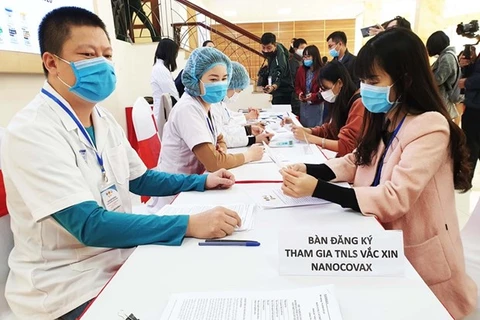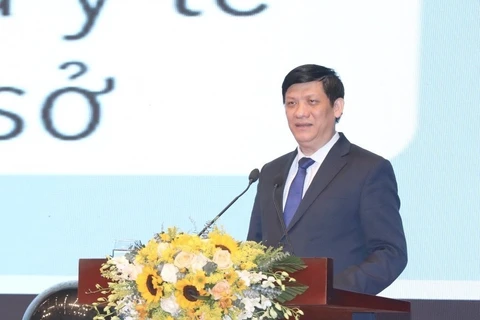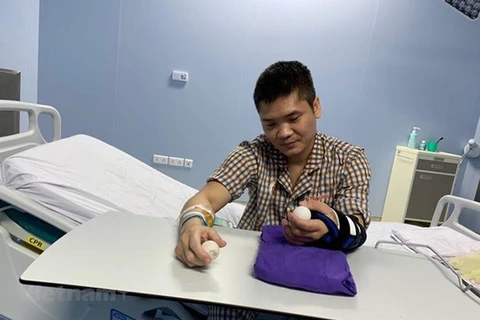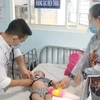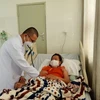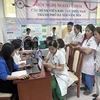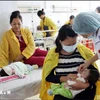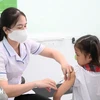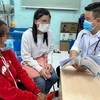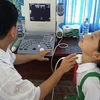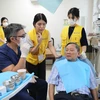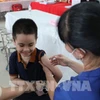Hanoi (VNA) – As the fight against the COVID-19 pandemic has yet to end, provinces and cities across the country need to stand ready for the peak time of COVID-19 prevention and control, viewing it as a key and long-term task.
Recently, variations of the coronavirus SARS-CoV-2 require stronger determination of the health sector and relevant agencies in this tough battle, as ensuring a safe Tet (Lunar New Year) holiday for citizens is deemed a foremost and long-term task.
Minister of Health Nguyen Thanh Long made the remark during a national health conference held on January 6 in Hanoi, which was to assess results, experience and development orientations of the sector as a whole in the coming time.
Health sector meets two main targets
Speaking at the event, Prime Minister Nguyen Xuan Phuc affirmed that despite many hardships, challenges and especially the adverse impact of the ravaging pandemic, the health sector gained important achievements in 2020 thanks to due the attention of the Party and State, the engagement of the whole political system, armed forces and people, contributing to the successful realisation of the dual targets of curbing the spread of COVID-19 and promoting socio-economic development.
As a result, Vietnam has become a bright spot in the fight against COVID-19.
Long said that in the last year, the sector obtained two main targets assigned by the National Assembly and the Government in the socio-economic development plan, which were raising the ratio of inpatient beds per 10,000 population to 28, and health insurance coverage to 90.85 percent.
In addition, various accomplishments were maintained, as the country’s replacement level fertility stabilised for 14 years in a row and sex ratio imbalance at birth was reduced. Average life expectancy reached 73.7 in the year, up 0.1 from that in 2019.
The Healthy Vietnam Programme approved by the PM has started to prove efficiency. According to the National General Nutrition Survey for 2019-2020, Vietnamese people’s stature improved, as average height was 168.1 cm for young men (growing 3.7 cm compared to 2009) and 156.2 cm for women (up 2.6 cm).
The rate of malnutrition among under-5 children in Vietnam was found to be 19.6 percent, a low level in accordance with classification of the World Health Organisation (WHO).
Quality of medical examination and treatment, as well as people’s satisfaction to health care services continued to improve.
New and advanced medical techniques were successfully applied. Of note, the Ho Chi Minh City Children’s Hospital performed a major surgery to separate conjoined twins, while the Vietnam-Germany Friendship Hospital completed 23 organ transplants on 13 days.
A project on remote health checkup and treatment was launched. Up to 1,000 points of checkup were available on the first 45 days, and the figure has raised to 1,500 nationwide so far. Capacity of the health network at grassroots level was also improved.
According to the Health Ministry, 2020 witnessed robust administrative reform as well as information technology application in medical tasks. The ministry was ranked fourth among ministries and sectors in IT application and among two ministries that provide 100 percent of online public services at level 4, the highest level.
Improving capacity of preventive medicine
Vietnam has to date kept COVID-19 under control and effectively treated severe patients. The country’s efforts have been highly valued by international organisations and friends.
In the past year, the health sector efficiently prevented the return of dangerous infectious diseases, such as diphtheria in the Central Highlands, Whitmore in the central region, scrub typhus in some northern localities, thereby avoiding risks of various diseases to break out at the same time.
The Health Minister said Vietnam was a bright spot in battling the pandemic in 2020.
Alongside Nano Covax whose clinical trial is underway, two homegrown COVID-19 vaccine candidates will enter the phase in the near future.
Long underlined that the health sector will focus on improving the capacity of preventive medicine to cope with emergencies and public health incidents, as well as ensure food safety./.


